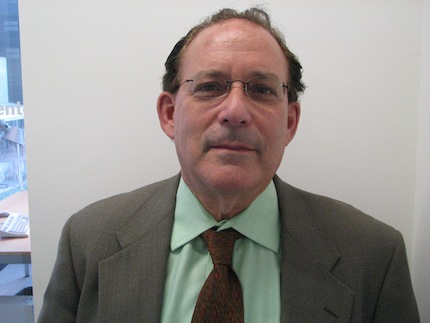
Film Theaters Are Galleries
A conversation with Laurence Kardish, senior curator at New York's Museum of Modern Art (MoMA).
13/06/2012
The role of MoMA in today's art world, and in the definition of the hierarchy thereof, is self-explanatory. This is an art institution who's influence doesn't stop at the city limits of New York, nor the American border, for that matter. MoMA exhibitions are usually happenings that can be defined on a global scale, and their influence on art processes and the creation/writing of art history is indisputable. Those who have had the opportunity to view not only MoMA's exhibits, but its film showings as well, know that the Museum of Modern Art is also one of the best places in New York for the viewing of independent films. Unlike in Latvia, where the dominant view is that film's sole purpose is entertainment, i.e. a commercially oriented mass-culture machine, the absurd discussions of whether film is art or an “orgy for the masses” doesn't exist here. MoMA proposes the view that film is a completely acceptable form of today's art, with a rich, scrupulously researchable history. Consequently, there are always several screens at MoMA showing daily film programs. These films are very thematically diverse – retrospectives of world-famous directors, conceptual showings, documentary film selections, dramatic film premiers, national cinematography selections, and films meant for general film audiences (children under 17 are admitted free of charge). One could even say that the MoMA film listings are a never-ending, high-end film festival. Laurence Kardish, Senior Curator of MoMA's Department of Film, however, wouldn't agree with this designation because “at festivals, films are selected, whereas at MoMA, we offer curator-created film programs.” Which is why the lexicon of MoMA curators does not include “film showings”, but rather “film exhibitions”. Here, films are pieces of art, just like the ones on view in MoMA's exhibition halls. Laurence Kardish, with whom I spoke in New York, has worked at MoMA since 1968; he has put together hundreds of exhibitions and catalogs, and has been on the juries of the world's leading film festivals.
Laurence Kardish
Film plays a very important role in the strategy of MoMA. Would you be so kind as to explain how this was achieved?
The Museum of Modern Art was established in November 1929, with the idea that film is the art of the XX century and it will be collected, exhibited, cataloged and enjoyed as any other art – just like paintings and sculpture. It was a radical decision made very early. The Museum was founded by a group of privileged women* who rebelled against against the older European art that their fathers and husbands were collecting. And they hired the art teacher from Wellesley College (Alfred H. Barr Jr. - D.R.), who became the director of the new Museum, which was very small then; he was also the one who established the film department. The museum was opened to the public in 1929, nine days after the Wall Street stock market crash. Even though the founders were wealthy, they didn’t have the money to collect films. That didn’t start before 1933, when it was decided that the Film Library would finally be established.
Iris Barry, who was the Museum’s librarian, became the world's first film curator. She began collecting films by going, first of all, to Hollywood, to convince the people in Hollywood that their work – films – should be collected; later on, she went to Europe – to London, Paris, Berlin and Moscow – gathering films for the MoMA collection. Ever since the beginning of MoMA, the concept that film is an art which should be collected was conceptual. At the very beginning of this organization, film was considered a very important part of the collection. Very often, other museums have films in their Educational Departments, but MoMA was the first museum that considered film as a very important part of its collection. Now there are a handful of institutions in the world in which film is collected as an art form, but MoMA was the first.
If you are a member of the Museum, you can come to any of the collections and visit the museum free of charge, which means you can see a minimum of 400 films per year, free of charge. Film theaters are galleries – that’s the idea. We have a curatorial department, and part part of the idea is collecting with the curatorial eye. In our archives there are thousands of films – we keep them a hundred kilometers away in Pennsylvania, in optimal conditions. We bring films to the attention of the New York public, because every museum in this state (I can’t speak for other states) is chartered as an educational institution; so we educate the general public, we show films which, in our opinion, deserve to be shown and discussed.
Do you obtain films for the MoMA collection from the programs that are shown here?
Sometimes we do and sometimes we don’t. We are just like any other department within the Museum, we borrow from other, different sources – studios, organizations, artists themselves – because we show all sorts of films – independent films, films made within the industry, etc. Not everything we show is in our collection. Maybe about under 30% of the films which we show come from the MoMA collection.
We have something called a circulating library, which existed even before our exhibition programs – we were pioneers of the distribution of 16 mm films to film studies' groups at schools and libraries. We still maintain that circulating library, even though most educational institution don’t use it any more – they use DVDs and keep these DVDs in the library for their students.
How do you choose what to show in MoMA?
There are a number of curators in our department, and we have two theaters that we keep running every day. Sometimes we use a third theater. We look at the scope of what we have decided during the year in order to have a variety of programs – we discuss it among ourselves and come up with various ideas. There is no one way how we make decisions. Everything we show has been curated, someone has made a selection.
Do you search ideas, trends, in major film festivals? What sort of interaction do you have with the festivals, for example, between the Cannes Film Festival program and MoMA film exhibitions?
Film festivals don’t have curated exhibitions, they have selections, but of course we go to various festivals, because we want to see what is happening in world cinema. We are a Museum of Contemporary Art – we have to know what is going on. Like, for instance, some art curators go to biennials and art fairs; I do too, but we also we go to film festivals. If the film festival is good, you got to see a lot of new work that has been done well; you get to meet a lot of international colleagues. These are wonderful places to meet a lot of people from around the world, and to see good films.
What kind of film exhibitions are planned for the near future under your supervision?
I am curating the exhibition French Thrillers Produced by Gaumont. I am calling it “100 Years of Murder and Mystery”, starting with Fantomas (1913) and finishing with a film that has not yet opened here, A Gang Story. I am going to show a film by Robet Siodmak, which he made after he left Germany but before he came to the USA, which is where he really developed film noir – he made a true film noir – a French one – in Paris in 1939. It is called Piège (Trap) – it is very hard to see this film anywhere and I am bringing it over to America. That is one of the shows which is coming up. Another is... Over the years, Broccoli, who was the producer of James Bond, has given every James Bond film to the museum; on the 50th anniversary, we are going to do a retrospective of James Bond films – this will happen later this year. We have an upcoming retrospective of the German filmmaker Werner Schroeter. We have an upcoming festival of film preservation – newly restored films on 35 mm prints. We also have annual programs showing new films from Brazil, Canada, Germany, Korea...
How do you choose which national cinemas are important right now – which ones might be interesting as a MoMA exhibition?
The main argument is – if the country has an ongoing film culture, and if there is an organization within the country with which we can work. We just look for a lot of films from the selected countries – for the Canadian show I go to Montreal, and I have a look at 80-90 works. I also go to the Cannes, Toronto and Sundance Festivals, and I see a lot of films there, too.
Do you depend on admissions? Do you have to respect the commercial aspect of the exhibitions that are shown in MOMA?
No.
Can anybody tell you – “this topic will not be popular, cancel it”?
They can tell us that this topic will not be popular, but if it is important, we will do it. Because we don’t have a box office. We are funded basically by the museum – they give us a budget every year and we have to work within it. Of course, we want people to come, and we don’t want to have just 20 people in the audience, but if we want to do the topic, we will. There is a Canadian filmmaker, Allan King, who is not very well known here – and we did his retrospective; it was very well regarded, but very few people came. He was very famous in Canada, but not here…
How can small film countries catch the attention of the MoMA curators?
There are a variety of ways. The Lithuanian film exhibition in MoMa came about thanks to the mentoring of Jonas Mekas – he helped to find contacts in Lithuania. I watched a lot of Lithuanian films and discovered that I can put a program together – there have been a lot of very interesting films made since Soviet times, since liberation.
Was it a success with audiences?
More or less – people liked it. It didn’t get much press, but I guess it was a success.
I don't know a lot about Latvian films – I have seen only some works by the female director which were shown in Cannes...
Laila Pakalnina?
Yes. She is the only filmmaker that I really know and I like her work very much. Naum Kleiman from the Moscow Film Museum once said that there were very interesting films made in Latvia during soviet times; I just don’t know a lot about it yet.
* The idea for The Museum of Modern Art was developed in 1928, primarily by Abby Aldrich Rockefeller (wife of John D. Rockefeller Jr.) and two of her friends, Lillie P. Bliss and Mary Quinn Sullivan.
